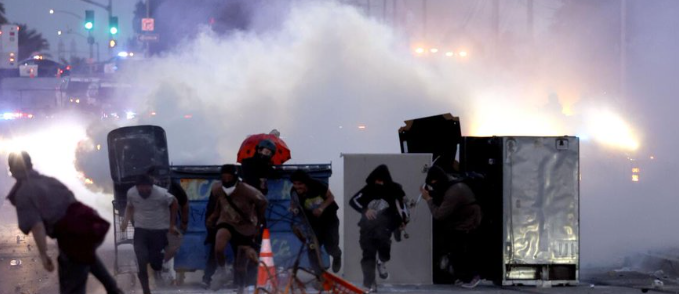Los Angeles Protest:Violent protests erupted in South Los Angeles after federal immigration raids led to over 100 arrests, prompting President Trump to deploy 2,000 National Guardsmen without state approval. This article explores 7 key developments—from the clash between protesters and police to the legal and constitutional showdown over Trump invoking the rarely used Insurrection Act. With California leaders opposing the move and legal experts warning of federal overreach, the crisis reflects deeper tensions between state and federal power in the U.S.
Los Angeles Protest
Police forces in riot gear clashed with hundreds of protesters in South Los Angeles following a federal immigration raid that sparked widespread outrage in a predominantly Latino neighborhood. The confrontation unfolded after immigration agents conducted a roundup of day laborers at a local building supply store. As word of the raid spread, residents flooded the streets to express their anger, condemning the aggressive tactics used by authorities.
One local resident described the police response as hostile and aggressive, stating that such treatment was unacceptable, regardless of individuals’ immigration status. The protests quickly escalated, with demonstrators setting a car on fire in the middle of the street, sending thick smoke into the air. Others attempted to help those affected by tear gas and pepper spray, as the area turned into a chaotic scene.
Authorities urged people to return to their homes, stating that while peaceful protest is allowed, the demonstrations were beginning to impact local businesses and daily life in the city of Paramount. Business owners were concerned about economic losses amid the disruptions.
The raid was part of a broader enforcement action carried out over two consecutive days. On Friday, federal agents stormed a clothing store near downtown Los Angeles. According to the Department of Homeland Security, over 100 undocumented migrants have been arrested during raids across Southern California. A senior White House official, Stephen Miller, characterized the protests as an “insurrection against the United States,” further intensifying the political rhetoric surrounding the incident.
The Trump administration’s enforcement actions appear designed to send a message, especially in Los Angeles, where roughly one-third of the population is foreign-born. Mayor Karen Bass criticized the raids, saying they instill fear and terror in immigrant communities. Despite vocal opposition from residents, Democratic politicians, and activists across California and beyond, the administration has signaled its intent to continue deportations as part of its core policy agenda.
In a major escalation, President Donald Trump announced the deployment of 2,000 National Guardsmen to Los Angeles. This move has drawn legal and constitutional scrutiny. Civil and human rights attorney Robert Patillo explained the rare legal mechanisms behind such a deployment. Under the Posse Comitatus Act of 1878, federal troops are prohibited from engaging in domestic law enforcement. This law was a product of post-Civil War negotiations and the end of Reconstruction, ensuring that military force wouldn’t be used to control civilian populations within states.
An exception to this law is the Insurrection Act of 1807, which has been invoked only a few times in U.S. history. President Dwight Eisenhower famously used it in 1958 to enforce school desegregation in Arkansas and protect students such as Ruby Bridges. In the current situation, President Trump would need to use this same Insurrection Act if he wants to federally activate the National Guard for law enforcement purposes in California.
Under normal circumstances, the National Guard operates under state control unless a governor invites federal assistance. For example, in 1992 during the Los Angeles riots, California’s governor formally requested federal troop intervention. However, in this case, California Governor Gavin Newsom has not made such a request. In fact, he publicly opposed the federal action, posting on social media platform X (formerly Twitter) that the federal takeover of the California National Guard would only inflame tensions further.
If Trump sends federalized troops into California without the state’s consent, legal experts believe there will be immediate court challenges. Patillo noted that a judicial stay could be issued by an appeals court, and the case may ultimately need to be resolved by the U.S. Supreme Court. The situation raises concerns about executive overreach, especially since federal troops are not trained to function as civilian law enforcement officers. Their presence could increase risks for both protesters and local residents.
Title 10 of the U.S. Code governs the status of National Guard troops when they are federally activated. Under this status, guardsmen are paid by the federal government and are placed under federal command—typically used for overseas deployments. However, using Title 10 troops for domestic policing would require the invocation of the Insurrection Act.
Beyond the legal questions, the move has sparked fears about eroding democratic norms. Patillo warned that if the administration continues to use federal powers to override local governance—such as intervening in New York’s congestion pricing, influencing Harvard’s curriculum, suing law firms over diversity policies, and now deploying federal troops into a state without consent—it raises alarms about increasing centralization of power in the executive branch. He pointedly asked when so-called small government conservatives would recognize the dangers of consolidating such power in the hands of one leader.
Trump defended the move by claiming that if Governor Newsom and Mayor Karen Bass cannot manage the situation, then the federal government will. The political dynamic is undeniable, especially given California’s strong Democratic identity. Critics argue that Trump’s actions are as much about flexing political muscle as they are about immigration enforcement.
As legal challenges loom and national debate grows, Los Angeles has become a focal point in a broader conversation about federal power, immigration policy, and civil liberties. Whether these protests lead to changes in policy or further confrontations remains to be seen.
Disclaimer: This article is for informational purposes only. It reflects reported facts and legal analysis based on statements from various public sources. It does not constitute legal advice or express the opinions of this platform.

